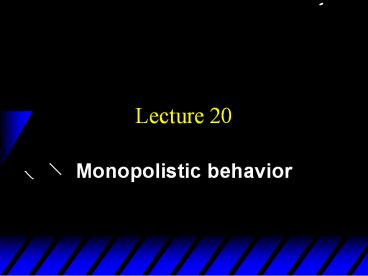Monopolistic behavior - PowerPoint PPT Presentation
Title:
Monopolistic behavior
Description:
Title: Chapter Twenty-Three Author: LSA Media Services, PC-69 Last modified by: Marek Weretka Created Date: 2/19/1997 3:45:54 AM Document presentation format – PowerPoint PPT presentation
Number of Views:62
Avg rating:3.0/5.0
Title: Monopolistic behavior
1
Lecture 20
- Monopolistic behavior
2
Uniform pricing
p
y
3
Elasticity and markup
4
Elasticity and Markup
- With MR0, elasticity
- Elastic part relevant
- Markup
5
TS, CS, PS and DWL
p
y
6
How Should a Monopoly Price?
- The same price for each unit to every customer -
uniform pricing. - Price discrimination many different prices for
the same good - Can price-discrimination earn a monopoly higher
profits?
7
Types of Price Discrimination
- 1st-degree Prices may differ across output units
and buyers. - 2nd-degree Prices may differ across output unit
but not buyers. (E.g. bulk-buying discounts.) - 3rd-degree Prices may differ across buyers but
not output units (student discounts) - Two part tariff
8
First-degree price discrimination
p
y
9
First-degree Price Discrimination
- First-degree price discrimination
- gives a monopolist all of the possible
gains-to-trade, - buyers are with zero surplus,
- efficient amount of output.
10
Third-degree Price Discrimination
- Market has segments - groups of buyers (seniors,
students, adults) - In each segment the same price
- Prices different across groups
- Common in real life
11
Third-degree Price Discrimination
- Example individual buyers, institutions
- Secrets of happiness
12
Third-degree Price Discrimination
- which of the two prices is bigger?
13
Third-degree price discrimination
14
Two-Part Tariffs
- A two-part tariff is a lump-sum fee, p1, plus a
price p2 for each unit of product purchased. - Thus the cost of buying y units of product
is p1 p2y. - Bars, Disneyland, many others
- Optimal design
15
Two Part Tariff
p
y
16
Two-Part Tariffs
- The monopolist maximizes profit by setting
- by setting per unit price p2 at MC
- lump-sum fee p1 equal to CS.
- Optimal two part tariff
- gives a monopolist all of the possible
gains-to-trade, - buyers are with zero surplus,
- efficient amount of output.































